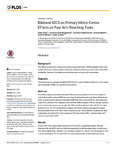Bilateral tDCS on primary motor cortex: effects on fast arm reaching tasks

View/
Use this link to cite
http://hdl.handle.net/2183/17267
Except where otherwise noted, this item's license is described as Creative Commons Attribution 4.0 International License (CC-BY 4.0)
Collections
- Investigación (FCS) [1293]
Metadata
Show full item recordTitle
Bilateral tDCS on primary motor cortex: effects on fast arm reaching tasksAuthor(s)
Date
2016-08-04Citation
Arias P, Corral-Bergantiños Y, Robles-Garcia V, Madrid A, Oliviero A, Cudeiro J. Bilateral tDCS on primary motor cortex: effects on fast arm reaching tasks. PLoS ONE. 2016;11(8)
Abstract
[Abstract] Background.
The effects produced by transcranial direct current stimulation (tDCS) applied to the motor system have been widely studied in the past, chiefly focused on primary motor cortex (M1) excitability. However, the effects on functional tasks are less well documented.
Objective.
This study aims to evaluate the effect of tDCS-M1 on goal-oriented actions (i.e., arm-reaching movements; ARM), in a reaction-time protocol.
Methods.
13 healthy subjects executed dominant ARM as fast as possible to one of two targets in front of them while surface EMG was recorded. Participants performed three different sessions. In each session they first executed ARM (Pre), then received tDCS, and finally executed Post, similar to Pre. Subjects received three different types of tDCS, one per session: In one session the anode was on right-M1 (AR), and the cathode on the left-M1 (CL), thus termed AR-CL; AL-CR reversed the montage; and Sham session was applied likewise. Real stimulation was 1mA-10min while subjects at rest. Three different variables and their coefficients of variation (CV) were analyzed: Premotor times (PMT), reaction-times (RT) and movement-times (MT).
Results.
triceps-PMT were significantly increased at Post-Sham, suggesting fatigue. Results obtained with real tDCS were not different depending on the montage used, in both cases PMT were significantly reduced in all recorded muscles. RT and MT did not change for real or sham stimulation. RT-CV and PMT-CV were reduced after all stimulation protocols.
Conclusion.
tDCS reduces premotor time and fatigability during the execution of fast motor tasks. Possible underlying mechanisms are discussed.
Editor version
Rights
Creative Commons Attribution 4.0 International License (CC-BY 4.0)






